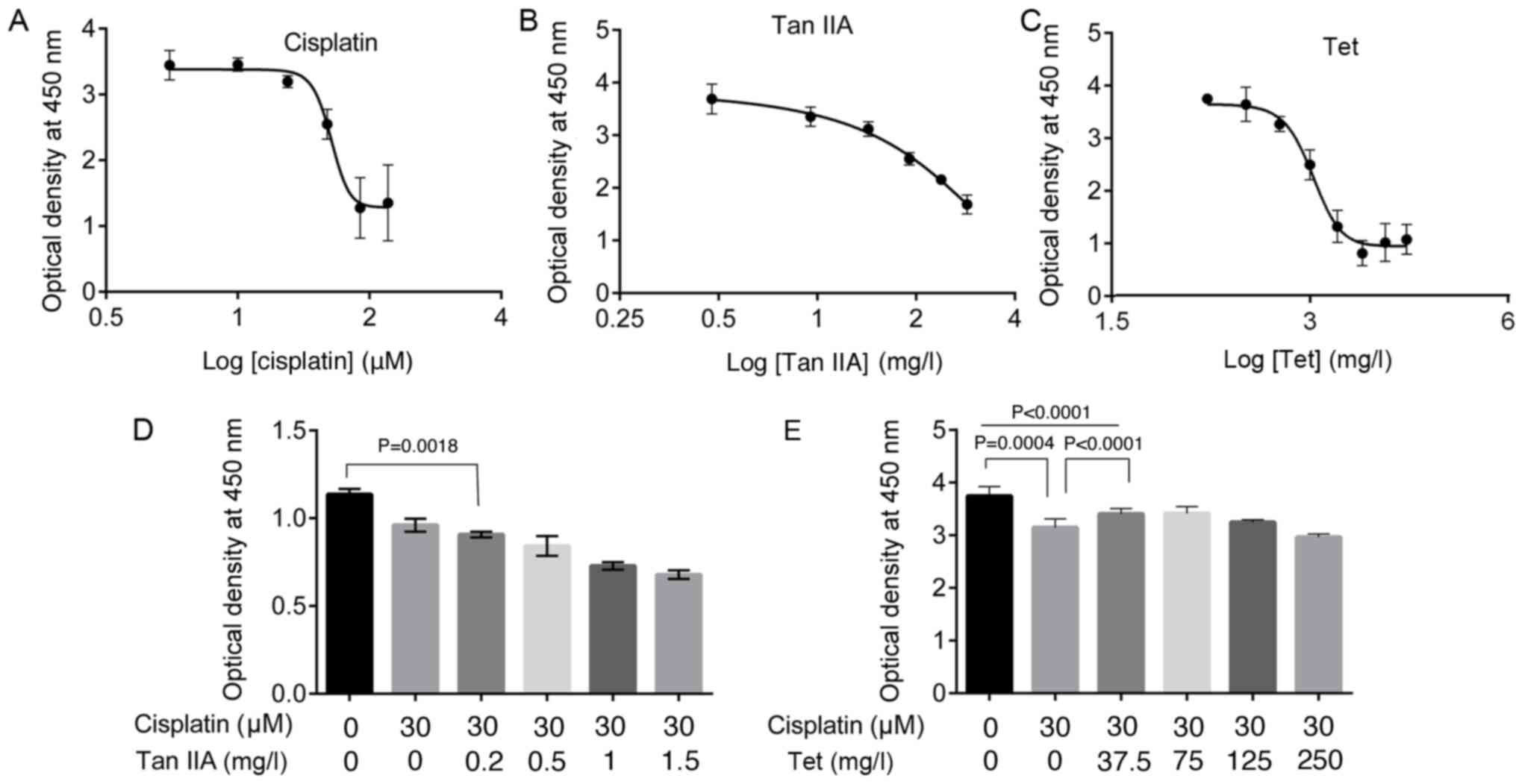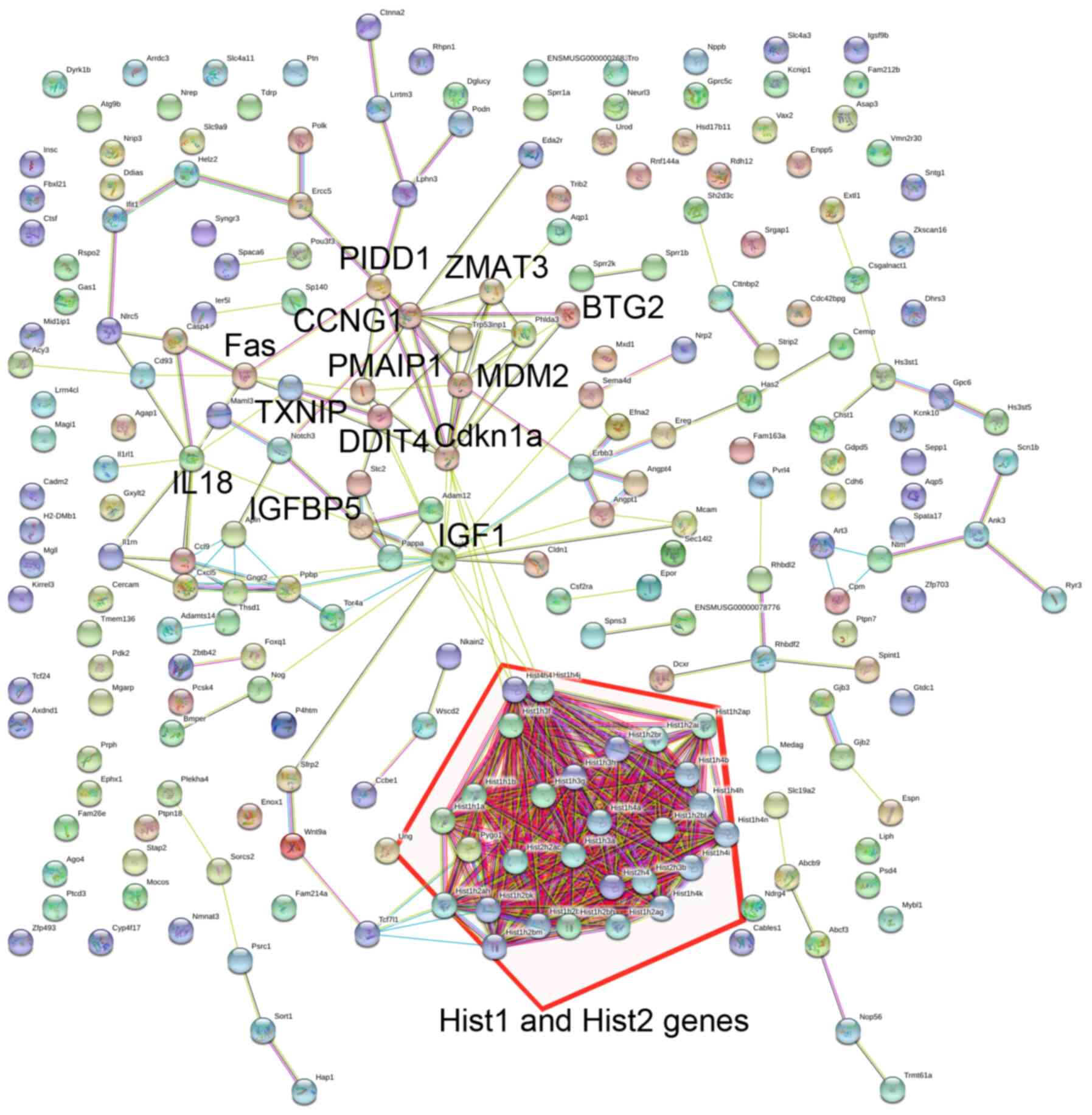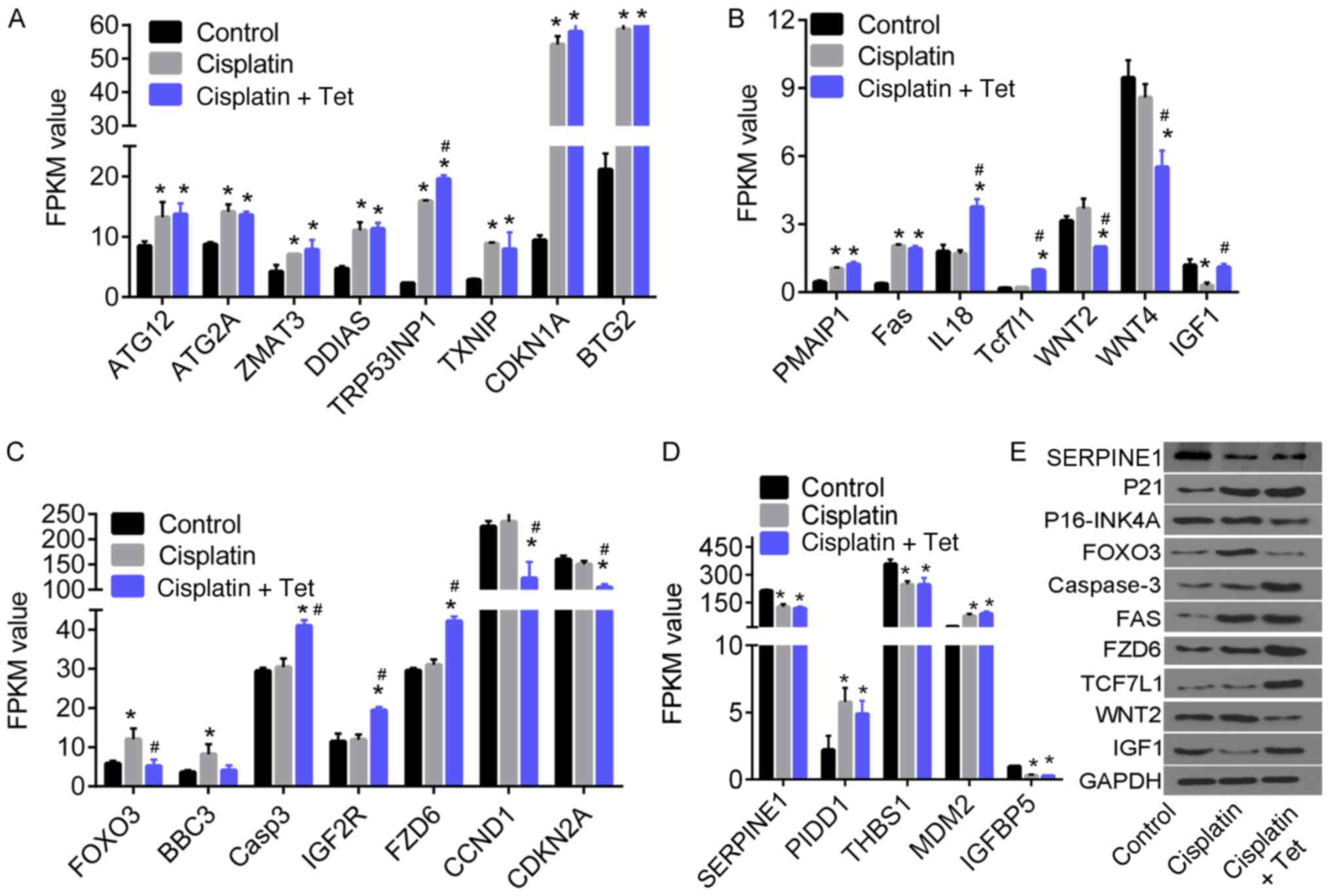|
1
|
Breglio AM, Rusheen AE, Shide ED,
Fernandez KA, Spielbauer KK, McLachlin KM, Hall MD, Amable L and
Cunningham LL: Cisplatin is retained in the cochlea indefinitely
following chemotherapy. Nat Commun. 8:16542017. View Article : Google Scholar : PubMed/NCBI
|
|
2
|
Shorter P, Harden F, Owen R, Panizza B,
Burmeister B, Sommerville J, Mengersen K and Foote M: Risk profiles
for sensorineural hearing loss in patients with head and neck
cancer receiving cisplatin-based chemoradiation. J Med Imaging
Radiat Sci. 48:61–67. 2017. View Article : Google Scholar : PubMed/NCBI
|
|
3
|
Wang J, Chen YY, Tai A, Chen XL, Huang SM,
Yang C, Bao Y, Li NW, Deng XW, Zhao C, et al: Sensorineural hearing
loss after combined intensity modulated radiation therapy and
cisplatin-based chemotherapy for nasopharyngeal carcinoma. Transl
Oncol. 8:456–462. 2015. View Article : Google Scholar : PubMed/NCBI
|
|
4
|
Robertson MS, Hayashi SS, Camet ML,
Trinkaus K, Henry J and Hayashi RJ: Asymmetric sensorineural
hearing loss is a risk factor for late-onset hearing loss in
pediatric cancer survivors following cisplatin treatment. Pediatr
Blood Cancer. 66:e274942019. View Article : Google Scholar : PubMed/NCBI
|
|
5
|
Bass JK, Hua CH, Huang J, Onar-Thomas A,
Ness KK, Jones S, White S, Bhagat SP, Chang KW and Merchant TE:
Hearing loss in patients who received cranial radiation therapy for
childhood cancer. J Clin Oncol. 34:1248–1255. 2016. View Article : Google Scholar : PubMed/NCBI
|
|
6
|
Wu X, Li X, Song Y, Li H, Bai X, Liu W,
Han Y, Xu L, Li J, Zhang D, et al: Allicin protects auditory hair
cells and spiral ganglion neurons from cisplatin-Induced apoptosis.
Neuropharmacology. 116:429–440. 2017. View Article : Google Scholar : PubMed/NCBI
|
|
7
|
Sheth S, Mukherjea D, Rybak LP and
Ramkumar V: Mechanisms of cisplatin-induced ototoxicity and
otoprotection. Front Cell Neurosci. 11:3382017. View Article : Google Scholar : PubMed/NCBI
|
|
8
|
Liu W, Xu X, Fan Z, Sun G, Han Y, Zhang D,
Xu L, Wang M, Wang X, Zhang S, et al: Wnt signaling activates
TP53-induced glycolysis and apoptosis regulator and protects
against cisplatin-induced spiral ganglion neuron damage in the
mouse cochlea. Antioxid Redox Signal. 30:1389–1410. 2019.
View Article : Google Scholar : PubMed/NCBI
|
|
9
|
Liu L, Chen Y, Qi J, Zhang Y, He Y, Ni W,
Li W, Zhang S, Sun S, Taketo MM, et al: Wnt activation protects
against neomycin-induced hair cell damage in the mouse cochlea.
Cell Death Dis. 7:e21362016. View Article : Google Scholar : PubMed/NCBI
|
|
10
|
Guo X, Bai X, Li L, Li J and Wang H:
Forskolin protects against cisplatin-induced ototoxicity by
inhibiting apoptosis and ROS production. Biomed Pharmacother.
99:530–536. 2018. View Article : Google Scholar : PubMed/NCBI
|
|
11
|
Zhang Q, Liu H, McGee J, Walsh EJ, Soukup
GA and He DZ: Identifying microRNAs involved in degeneration of the
organ of corti during age-related hearing loss. PLoS One.
8:e627862013. View Article : Google Scholar : PubMed/NCBI
|
|
12
|
Wang P, Zhang P, Huang J, Li M and Chen X:
Trichostatin a protects against cisplatin-induced ototoxicity by
regulating expression of genes related to apoptosis and synaptic
function. Neurotoxicology. 37:51–62. 2013. View Article : Google Scholar : PubMed/NCBI
|
|
13
|
Bhatta P, Dhukhwa A, Sheehan K, Al Aameri
RFH, Borse V, Ghosh S, Sheth S, Mamillapalli C, Rybak L, Ramkumar V
and Mukherjea D: Capsaicin protects against cisplatin ototoxicity
by changing the STAT3/STAT1 ratio and activating Cannabinoid (CB2)
receptors in the Cochlea. Sci Rep. 9:41312019. View Article : Google Scholar : PubMed/NCBI
|
|
14
|
Kitcher SR, Kirkwood NK, Camci ED, Wu P,
Gibson RM, Redila VA, Simon JA, Rubel EW, Raible DW, Richardson GP
and Kros CJ: ORC-13661 protects sensory hair cells from
aminoglycoside and cisplatin ototoxicity. JCI Insight.
4:e1267642019. View Article : Google Scholar
|
|
15
|
Cui C, Liu D and Qin X: Attenuation of
streptomycin ototoxicity by tetramethylpyrazine in guinea pig
cochlea. Otolaryngol Head Neck Surg. 152:904–911. 2015. View Article : Google Scholar : PubMed/NCBI
|
|
16
|
Du S, Yao Q, Tan P, Xie G, Ren C, Sun Q,
Zhang X, Zheng R, Yang K, Yuan Y and Yuan Q: Protective effect of
tanshinone IIA against radiation-induced ototoxicity in HEI-OC1
cells. Oncol Lett. 6:901–906. 2013. View Article : Google Scholar : PubMed/NCBI
|
|
17
|
Bayram A, Kaya A, Akay E, Hıra İ and Özcan
İ: The protective role of tetramethylpyrazine against
cisplatin-induced ototoxicity. Int J Pediatr Otorhinolaryngol.
94:1–7. 2017. View Article : Google Scholar : PubMed/NCBI
|
|
18
|
Hou LL, Xu QJ, Hu GQ and Xie SQ:
Synergistic antitumor effects of tanshinone II A in combination
with cisplatin via apoptosis in the prostate cancer cells. Yao Xue
Xue Bao. 48:675–679. 2013.(In Chinese). PubMed/NCBI
|
|
19
|
Chang TW, Lin CY, Tzeng YJ and Lur HS:
Synergistic combinations of tanshinone IIA and trans-resveratrol
toward cisplatin-comparable cytotoxicity in HepG2 human
hepatocellular carcinoma cells. Anticancer Res. 34:5473–5480.
2014.PubMed/NCBI
|
|
20
|
Banday AR, Baumgartner M, Al Seesi S,
Karunakaran DK, Venkatesh A, Congdon S, Lemoine C, Kilcollins AM,
Mandoiu I, Punzo C and Kanadia RN: Replication-dependent histone
genes are actively transcribed in differentiating and aging retinal
neurons. Cell Cycle. 13:2526–2541. 2014. View Article : Google Scholar : PubMed/NCBI
|
|
21
|
Kadri Z, Lefevre C, Goupille O, Penglong
T, Granger-Locatelli M, Fucharoen S, Maouche-Chretien L, Leboulch P
and Chretien S: Erythropoietin and IGF-1 signaling synchronize cell
proliferation and maturation during erythropoiesis. Genes Dev.
29:2603–2616. 2015.PubMed/NCBI
|
|
22
|
Yu M, Wang H, Xu Y, Yu D, Li D, Liu X and
Du W: Insulin-like growth factor-1 (IGF-1) promotes myoblast
proliferation and skeletal muscle growth of embryonic chickens via
the PI3K/Akt signalling pathway. Cell Biol Int. 39:910–922. 2015.
View Article : Google Scholar : PubMed/NCBI
|
|
23
|
Bruchim I, Attias Z and Werner H:
Targeting the IGF1 axis in cancer proliferation. Expert Opin Ther
Targets. 3:1179–1192. 2009. View Article : Google Scholar
|
|
24
|
Jeon JH, Kim SK, Kim HJ, Chang J, Ahn CM
and Chang YS: Insulin-like growth factor-1 attenuates
cisplatin-induced gammaH2AX formation and DNA double-strand breaks
repair pathway in non-small cell lung cancer. Cancer Lett.
272:232–241. 2008. View Article : Google Scholar : PubMed/NCBI
|
|
25
|
Du J, Shi HR, Ren F, Wang JL, Wu QH, Li X
and Zhang RT: Inhibition of the IGF signaling pathway reverses
cisplatin resistance in ovarian cancer cells. BMC Cancer.
17:8512017. View Article : Google Scholar : PubMed/NCBI
|
|
26
|
Sun Y, Zheng S, Torossian A, Speirs CK,
Schleicher S, Giacalone NJ, Carbone DP, Zhao Z and Lu B: Role of
insulin-like growth factor-1 signaling pathway in
cisplatin-resistant lung cancer cells. Int J Radiat Oncol Biol
Phys. 82:e563–e572. 2012. View Article : Google Scholar : PubMed/NCBI
|
|
27
|
Chan D, Zhou Y, Chui CH, Lam KH, Law S,
Chan AS, Li X, Lam AK and Tang JCO: Expression of insulin-like
growth factor binding protein-5 (IGFBP5) reverses
cisplatin-resistance in esophageal carcinoma. Cells. 7:1432018.
View Article : Google Scholar
|
|
28
|
Liu S, Zhang X, Sun M, Xu T and Wang A:
FoxO3a plays a key role in the protective effects of pomegranate
peel extract against amikacin-induced ototoxicity. Int J Mol Med.
40:175–181. 2017. View Article : Google Scholar : PubMed/NCBI
|
|
29
|
Rupp M, Hagenbuchner J, Rass B, Fiegl H,
Kiechl-Kohlendorfer U, Obexer P and Ausserlechner MJ:
FOXO3-mediated chemo-protection in high-stage neuroblastoma depends
on wild-type TP53 and SESN3. Oncogene. 36:6190–6203. 2017.
View Article : Google Scholar : PubMed/NCBI
|
|
30
|
Fitzwalter BE and Thorburn A: FOXO3 links
autophagy to apoptosis. Autophagy. 14:1467–1468. 2018. View Article : Google Scholar : PubMed/NCBI
|
|
31
|
Ma W, Li J, Hu J, Cheng Y, Wang J, Zhang X
and Xu M: MiR214-regulated p53-NOX4/p66shc pathway plays a crucial
role in the protective effect of Ginkgolide B against
cisplatin-induced cytotoxicity in HEI-OC1 cells. Chem Biol
Interact. 245:72–81. 2016. View Article : Google Scholar : PubMed/NCBI
|
|
32
|
Xiong H, Pang J, Yang H, Dai M, Liu Y, Ou
Y, Huang Q, Chen S, Zhang Z, Xu Y, et al: Activation of
miR-34a/SIRT1/p53 signaling contributes to cochlear hair cell
apoptosis: Implications for age-related hearing loss. Neurobiol
Aging. 36:1692–1701. 2015. View Article : Google Scholar : PubMed/NCBI
|
|
33
|
Benkafadar N, Menardo J, Bourien J,
Nouvian R, François F, Decaudin D, Maiorano D, Puel JL and Wang J:
Reversible p53 inhibition prevents cisplatin ototoxicity without
blocking chemotherapeutic efficacy. EMBO Mol Med. 9:7–26. 2017.
View Article : Google Scholar : PubMed/NCBI
|



















